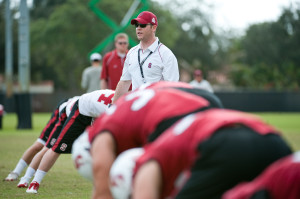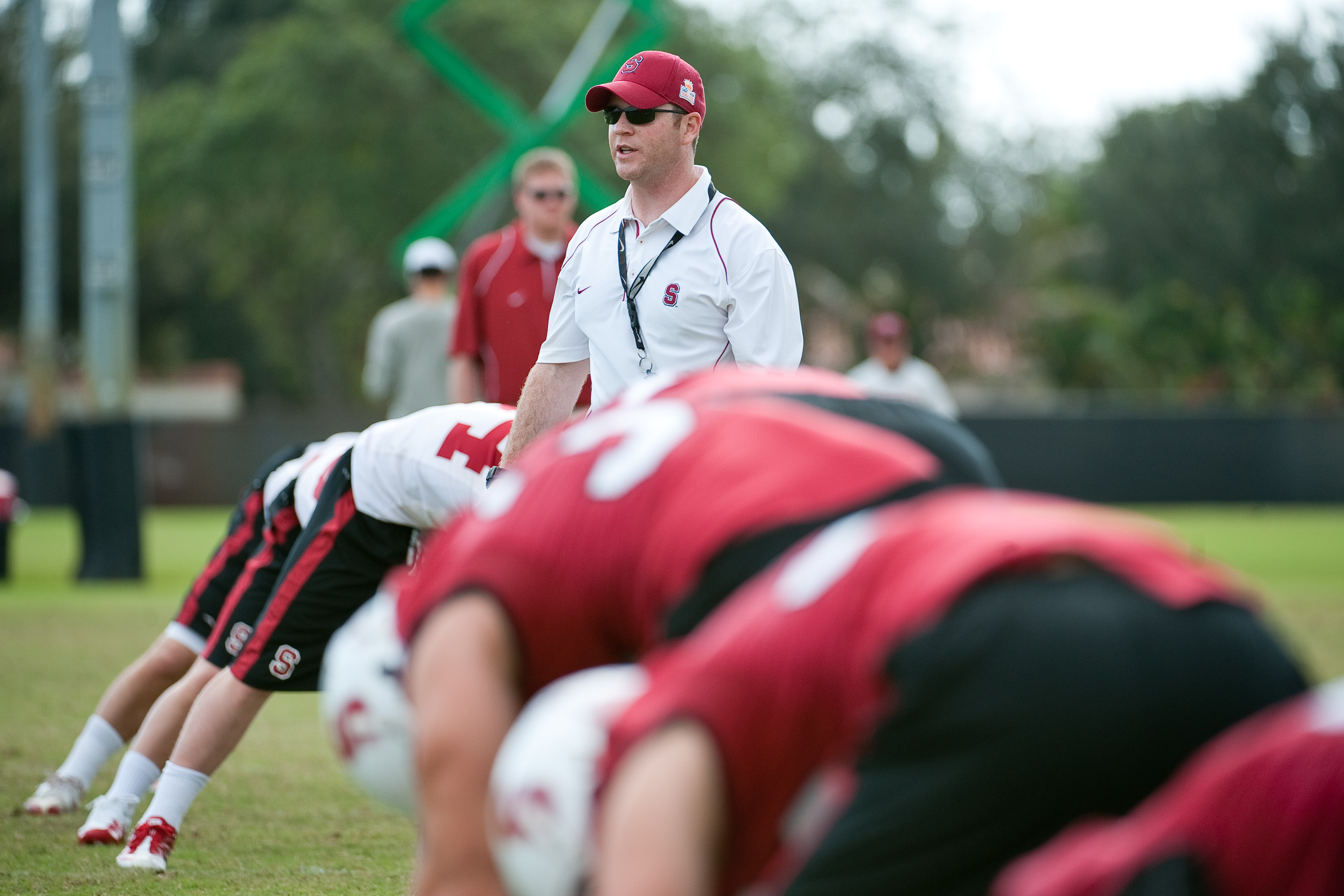This is the second piece of a three-part feature on Shannon Turley, the sports performance coordinator entering his seventh season with Stanford football. Part II focuses on the nuts and bolts of Turley’s training regimen. Stay tuned for Part III, which will be published on Friday.
What drives the wildly successful training philosophy of Shannon Turley? Here is an example: It’s a beautiful spring day on the Farm, and instead of being totally dumbstruck by Shannon Turley, I am now positively terrified by the freshman year version of Alex Debniak.
“I was spotting Andrew Luck on squats, and it was actually a little too heavy for him at the time,” Debniak says. “This was when I first got here. And he actually ended up crashing on the squat rack, and it made this loud noise, and everybody in the weight room thought that he broke his leg or shattered or something. And of course I’m standing behind him looking dumbfounded because I wasn’t paying much attention.”
Debniak sheepishly grins, “I got a pretty good mouthful from Turley. He was pretty angry. He couldn’t talk to me for the rest of the day.”
***
The Luck incident presents a question: What is more important, the outcome or the process? Luck, then a freshman, was not injured and in fact went on to have a fine college career, so the outcome of the accident was acceptable. But the accident was clearly unacceptable, and if repeated, would likely have laid waste to not just Luck but the entire Stanford football team. The key takeaway from Turley’s philosophy is that the process is more important than the outcome.
“We’re very process-oriented as players and as a program,” Turley says. ‘”We want to concentrate on those things we can control and take absolutely no talent to master.
“Winning games, winning awards and trophies—we’re going to leave that up to other people, because we don’t have any control over that.
“That’s a big concept,” he admits.
***
As might be expected, the Stanford players initially had trouble digesting Turley’s philosophy. “It was incredibly frustrating to deal with at first,” remembers Andrew Phillips. “Memorizing little passages and talking about getting your foot over the line [during sprints]—you gotta win football games!” Coming off a one-win season in 2006, focusing on performance seemed more critical than ever.

Turley attempted to instill a commitment to the process by being very particular about how his players performed their exercises and drills. A system of rewards and punishments was devised for everything from lifting to sprints. Slogans were assigned and expected to be memorized. Daily attendance at breakfast—Turley studied nutritional science in college—became required.
“You have to be demanding,” Turley insists. “You can’t compromise.”
However, the hallmark of Turley’s method was, and still is, the goal system. Before each practice, every Stanford player is given a set of goals to achieve, the nature of the goals reflecting Turley’s own beliefs: One of the goals is outcome-based, two are performance-based and five are process-based (give or take a goal or two). The latter goals might encourage proper weight room safety, for example, or increased effort in practice.
If Stanford was going to improve, it would require a workable, innovative plan for doing so, and it would have to convince its players that that plan would be effective. At the same time 2,300 miles away, Nick Saban—then just beginning his highly successful tenure at Alabama—was installing the slogan “It’s All Part of the Process,” but the Cardinal and Crimson Tide were two different animals.
“I can’t tell these kids to do something ‘just because,’ and I can’t say that we need to do something because Alabama does it that way and Alabama wins national championships,” Turley says. “They’re not going to buy it. I couldn’t really say, ‘Well, this is how we did it at San Diego,’ a 1-AA non-scholarship team. So you have to be able to explain why what you’re doing is going to make them a better player.”
***
Part of this internal resistance to the process comes from football analysts’ longstanding fixation with numbers. Even now, with today’s Stanford football miles better than its 2006 counterpart, Turley sees a certain degree of skepticism among the football community, where the NFL Combine has turned quantifications such as the bench-press test into a fetish. As Turley pointed out to Phillips years ago, “If you’re at the point where you’re on your back…pushing weight up off the ground, you’ve already lost.”
The recently graduated Debniak, whom Turley is currently preparing for this week’s NFL draft, is going through this same problem with the pro scouts.
“They really put a lot of emphasis on a lot of those numbers,” he says. “And why not? That’s what they’ve been doing for so many years now. But I think the sport is evolving always, and I think if some of these scouting services and the NFL don’t wish to change their views on stuff, I think it’s a little bit frustrating for Coach Turley and our staff, because they have different ideas.”
“Too often, in my role you see a guy that is number-hungry,” Turley adds, “and he’s more concerned with the NFL Combine type of statistics—how much a guy can bench press, how much a guy can back squat, how much a guy can power clean.”
Debniak—who benched 225 pounds 25 times at Stanford’s pro day, which would have placed an impressive eighth among linebackers at the NFL Combine—is then quick to clarify: “He’ll play to their game, though, and we’ve consistently put up really good numbers in bench, so I don’t think you can really complain much about that.”
***
Put simply, the purpose of Turley’s program is not to get big. When describing his system, Turley even shies away from the word “lifting,” preferring to use the more expansive term “sports performance.” True to form, even his official title is sports performance coordinator, not strength coach.
The new paradigm of football training, he insists, encompasses not just conditioning but nutrition, psychology (especially the aforementioned goals) and sports medicine. A specialist in nutrition at Virginia Tech and psychology as a graduate student at Missouri, Turley refuses to allow these areas to go overlooked.
Philosophically, the number one goal of Stanford’s conditioning program is to avoid injuries. Upon joining the team, Stanford football players are extensively tested for their movement, flexibility, balance and physical stability, as well as potential risk factors. Steve Bartlinski, the team’s trainer and coordinator of injury rehab, estimates that the staff’s focus on identifying possible causes of injury has reduced Stanford’s re-injury rate significantly, and indeed, the Cardinal’s 2012 Rose Bowl campaign enjoyed fantastic roster continuity and relatively few major injuries in a sport full of them. Every single starter at the beginning of the season was healthy and available for action in the Rose Bowl.
Most astonishingly, Stanford’s Director of Football Operations Matt Doyle estimated that Stanford’s starters missed a combined total of more than 60 games in 2006; six years later, one “could count the number of games lost by starters on one hand.”
Turley never relaxes his standards, even when a player is sidelined. An individual rehabilitation plan is developed for every recovering athlete. “There’s going to be a stepwise process that these guys have to go through to earn their way back out into practice,” he says. “So they’re going to have to be able to do things first in physical therapy and then in the athletic training room before they can do them with me…We want him back on the field better than he was before.”
“The old days of ‘Hey, you look pretty good, go play’ are over. We have to quantify and qualify them through a process in order to have them return,” Bartlinski says. “I think people still unfortunately still go by timelines. If past literature dictates that somebody’s out for six months, when that six-month mark comes up, they’re either cleared to return, whether they’re ready or not.”
Stanford’s sparkling injury record has not gone unnoticed, especially by the athletes whose bodies are being entrusted to Cardinal football. Five years after committing to Stanford, Debniak remains grateful for Turley’s emphasis on player safety.
“I had a lot of security, going into Stanford with the understanding that they were really going to take care of us,” he says. “Coming out of high school, I had a couple injury issues, and that was something I really appreciated from him.”
***
Turley’s guiding principle on injuries is that players who are stronger on the football field are less susceptible to injury in the first place. Consequently, everything in Stanford’s conditioning program is designed with football in mind. If an exercise is not relevant to football in some way, Turley deemphasizes it, and if an exercise is relevant to football, Turley may incorporate it into his program. Some of his more unorthodox methods include pushing trucks, squatting with one foot in front of the other (“It’s actually pretty challenging,” Phillips explains) and an end-of-practice favorite resembling an extremely one-sided game of tug-of-war.
Turley is also not afraid to borrow ideas from other people. Trained in the classic Olympic lifts (power cleans, jerks and the like) under Mike Gentry at Virginia Tech, Turley nevertheless has adopted elements from many different schools of conditioning, convinced that no single style of lifting corresponds perfectly to football. “Power cleans, Olympic-style lifting—that’s a sport. Bodybuilding, that’s a sport. Powerlifting, that’s a sport,” Turley says.
Experienced in specialized training in track and football at Virginia Tech, baseball with the Kansas City Royals minor league system and volleyball and wrestling at Missouri, Turley understands the similarities and differences between sports more than most.
“We’re not training our athletes to be weightlifters,” Bartlinski adds. “Functionality on the field is our most important goal.”
To this extent, Turley and his equally overworked staff—Bartlinski estimates that at peak times, he and Turley typically work from 5 a.m. to 8 p.m.—take a very individualized approach to training for each of the football team’s 100-odd athletes.
But how?
***
Perhaps inevitably at a school in Silicon Valley, Turley has made technology a notable part of his program, allowing him to effectively keep tabs on every athlete on the team.
He brings in training equipment from a wide variety of sources. The “spaceship” in his office is actually a BodPod, which uses air displacement systems to analyze a player’s levels and concentrations of body fat and muscle. The Functional Movement Screen is a set of physical tests that surveys players’ physical abilities and limitations; Turley explains, “If there are compensatory movement patterns, if there are asymmetries, right versus left, in their movement patterns, then we’re going to have issues because that player is now predisposed to injury risk.” Perhaps the most remarkable innovation of all is the core-cooling glove developed by Stanford’s Dennis Grahn and Craig Heller, which allows athletes to work harder and longer in the weight room and on the playing field.
“We have great opportunities that only come because we’re at Stanford,” Bartlinski says.
At the same time, however, sometimes the old ways are best. Despite his use of technology, Turley espouses a fairly old-school approach to his charges’ nutrition.
“If they’re not eating right, if they’re not hydrating, if they’re not fueling for that work and recovering immediately after and then sleeping adequately, then all that work in that hour and a half does not mean anything,” he says.
Turley was more straightforward in an interview at Examiner.com: “If you can’t pick it, pluck it or kill it, you don’t eat it. It is not real food.”
Consequently, despite all of the various sources that make up the Cardinal system, there is one common goal: a focus on the player. Turley’s multi-faceted education has opened him to new ideas in the weight room, but only as long as it helps him put the players first.
“Until I understand [a new training technique]…I’m not going to utilize it with our team until I know where it fits in to the bigger picture of all those areas of our comprehensive program,” Turley says. “We want to make sure that we’re going right by our players. That’s first and foremost.”
Contact Winston Shi at wshi94 ‘at’ stanford.edu.

